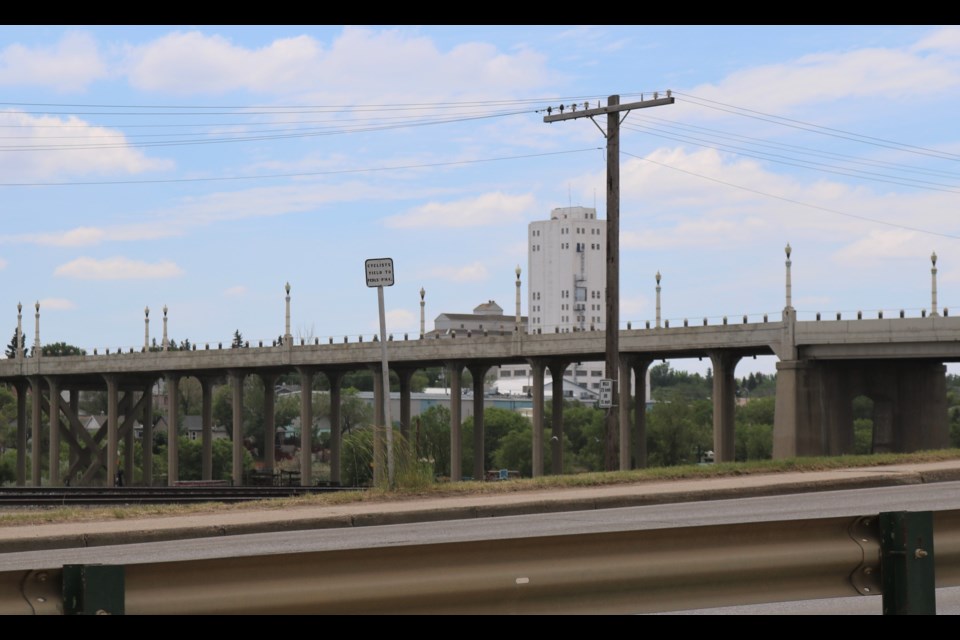This Saturday, June 8 is South of the Bridge Day. In conjunction with this celebration, this week we are presenting five facts about the Fourth Avenue Bridge.
It is not the original bridge
The Fourth Avenue Bridge was built in 1929. Prior to this, a flimsy wooden footbridge crossed Thunder Creek. It was known by some as the “Fifty Cent Bridge,” as children would often try to trick pedestrians into paying a toll. The wooden bridge was replaced in 1909 before the current viaduct was constructed in 1929. The bridge was officially opened on December 19, 1929 by Mayor James Pascoe. After the ceremony, 150 people paid $1 each to attend a gala banquet at the Grant Hall.
Design
The bridge was designed by Dr. Claude Allan Porter Turner, an engineer from Minneapolis. It is an example of the art moderne style of architecture. According to architectural historian Ross Herrington, Turner may have been influenced by the opening of Tutankhamen’s tomb in 1922, resulting in Egyptian elements. This can be seen in the terra cotta lamp standards, the coloured bollards along the bridge, and the ornate column heads supporting the structure.
The bridge is similar in design to the Albert Memorial Bridge in Regina, which Turner also worked on.
Who is that?
Along the bridge you will find images of moose, as well as two Indigenous men. These men are Bear Ghost and Mike Oka. So, just who were these men?
The answer is tricky. It seems as though Bear Ghost likely had a connection to the Moose Jaw Sioux, who fled to Canada after the Battle of Little Bighorn. A man by the name of Ted Bison from Sayre, Oklahoma once told late Moose Jaw historian Leith Knight that Bear Ghost was his great, great grandfather. There are, however, records of multiple men with the same name.
Mike Oka appears to have been a member of the Blood Tribe from southern Alberta.
It is possible, if not likely, that neither man spent much time in Moose Jaw. It is unknown why the artist who made these medallions opted to honour Mike Oka and Bear Ghost. Unfortunately, the city council of the day was not privy to the bridge’s design. Regardless, it is assumed that Bear Ghost and Mike Oka simply represent the Indigenous peoples who lived in the area for countless generations.
What’s in a name?
In 2017 a plaque was installed on the bridge that noted its true name is Thunderbird Viaduct. The bridge was given the name back in 1952 when council adopted a report providing naming suggestions for multiple bridges in the city. The report also recommended other bridges be known as Assiniboine Bridge, Blackfeet Bridge, Sioux Bridge, and Cree Bridge. The Thunderbird name was chosen, in part, because it was felt that Thunder Creek was named after the thunderbird of Indigenous culture.
The more things change, the more they stay the same
In June of 1988 the bridge was closed for much-needed repairs. Unfortunately, the repairs took longer than expected. In the meantime, the city and CPR fought over the more than $1 million in repairs, with both sides bickering over how to share the costs. Eventually, the National Transportation Agency stepped in to mediate.
During these tumultuous months, however, South Hill merchants said they were losing business while the bridge was closed. A similar problem emerged during High Street renovations in 2017-18, which resulted in one business (Scuba Guys’ Dive Shop) closing its doors.
Whether you choose to call it the Fourth Avenue Bridge or the Thunderbird Viaduct, it is a part of South Hill’s history and the city’s very identity.
Be sure stop by South of the Bridge Day this Saturday!




